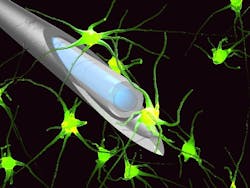FIBER-OPTICS: Single multimode fiber is imager for in vivo applications
Researchers at the University of St. Andrews (St. Andrews, Scotland) have shown for the first time how to unscramble highly disordered images sent down single multimode fibers, making for the narrowest image-guiding system ever. Their “order from disorder” approach means that single fibers could be fed down hypodermic needles, sending back deep-tissue images at a range of depths that more complex imaging approaches simply cannot reach.
The approach amounts to a characterization of the ways in which multimode fibers distort the phase of light as it propagates along the fiber, and then the application of a transformation at the other end to undo the distortions. With fine holographic control of the phase in place, the approach can also be used to select the location and size of the depth of focus—a one-fiber, lensless imaging system.
At the heart of the technique lies the idea that the classic microscopy imaging setup—with one lens performing a Fourier transform of the incident light and another performing the inverse transform to provide the viewed image—can be accomplished by any two optical elements that perform such orthogonal transformations. A single multimode fiber, with all of the depolarization, scattering, and randomization of the light that it creates, can be viewed as the source of one such transformation.
Creating order from disorder
In a landmark study, Tomáš Čižmár and Kishan Dholakia devised an optical setup that used a spatial light modulator (SLM) to complete the orthogonal transformation, creating order from disorder in single fibers.1 The SLM is an addressable liquid-crystal display that can independently modulate the phase and amplitude of light reflected off it (see figure).
The technique starts with a calibration step, in which light from a laser emitting at 1064 nm is reflected from the SLM, where it is decomposed into a set of orthogonal modes and then sent onward through the multimode fiber. The SLM is adjusted, pixel by pixel, to determine what modulation is required at the input to image the fiber face and generate points on a CCD camera that is split into a small number of regions. In this way, it is possible to determine, for a given CCD region, what amplitude and phase is needed to “undo” the effects of the fiber and the other optical components. The full holographic transformation is simply the superposition of all of the modulations across the focal plane at the fiber.
The researchers note that this calibration procedure would have to be carried out for each fiber that is eventually used in an imaging setup, but they find that for a given fiber, bending does not appreciably affect the image quality, and a given calibration can last for weeks at a time.
They started with straightforward bright- and dark-field imaging of 10 μm polymer particles. Putting the same order-from-disorder calibration to work, they went on to carry out fluorescence imaging and even the controlled generation of complex beam geometries such as Laguerre-Gaussian and “bottle” beams.2
Useful for in vivo imagingThese advanced techniques are particularly promising for super-resolution imaging methods such as stimulated emission depletion (STED) microscopy, and the extraordinarily thin nature of single fibers makes the technique most promising of all for delicate procedures such as in vivo neuro-imaging.
“Holographic control of randomized light signals is a young but very progressive discipline,” says lead author Čižmár. “It is only a few years since the first experiments, but we have already witnessed a number of immensely promising achievements—some of them originating in St. Andrews. Our new contribution represents a further extension of this branch to the biomedical community and we are looking forward to see what a further advancement of these techniques may bring in the future.”
REFERENCES
1. T. Čižmár and K. Dholakia, Opt. Exp., 19, 18871 (2011).
2. T. Čižmár and K. Dholakia, Nat. Comm., 3, 1027 (2012).
D. Jason Palmer | Freelance writer
D. Jason Palmer is a freelance writer based in Florence, Italy.
